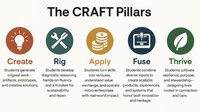I am a lifelong professional educator. But we are a disappearing breed. Teachers are leaving the classroom almost as quickly as colleges of education are preparing them.
I will never forget the first day of my teaching career. After filling out the required paperwork, I was taken by the Assistant Principal - Administration on a brief tour of the building. I had graduated from college and was convinced that my college professors had transmitted all of the knowledge and training that they possessed. I was certain that all I had to do was to use the techniques that I had been taught. The Assistant Principal pointed out where the teacher’s lounge was, where the teacher bathrooms were, and where my classroom was. He handed me a roll book, the keys to my classroom and wished me good luck. I thought, as he did, that my college had prepared me for any eventuality. I had graduated from college and was convinced that my university professors had trained me with the skills I needed to thrive in the educational system.
Those who prepare teachers cannot know where prospective teachers will work and cannot prepare them for every setting, location or every grade level. This time-consuming work must be done in the school. It is difficult to teach fledgling teachers to provide relevant material and instructional techniques to their students. Teachers requires skills that are difficult to master. Teachers and administrators need training and support to meet the ever-changing challenges of the profession.
I would like to share what I have discovered in my years in schools and share some wisdom from some of the most creative and innovative educators that I have had the privilege of working with. This experience can help educators better communicate with parents and students. I have taught students who were poor and those who weren’t. I’ve taught remedial classes as well as Advanced Placement classes. My college professors were interested in teaching me a great deal of theory but little that was practical that I could actually use in a classroom. So that when I graduated I had little more practical knowledge than when I started. My first school, a high school, was in Harlem, New York City. What did a young white male know about the economically challenged, minority students I was about to meet? What did my instructors at City University know about the culture of the school? It didn't take me long to learn that if I wanted to succeed as an educator, I would have to learn on the job. I want to share what I have learned over time. Unfortunately, my experience is not unique. What I have learned has come from personal experience – over time and by reading and listening to others in the field.
I estimate that I have delivered over 250 workshops to about 50,500 educators. I ask at each workshop, “How many of you were well-prepared to enter the classroom when you graduated from your school of education?” The vast majority said they weren’t. When teachers graduates from college they have a lot of book learning but are not competent to function as a quality educator. It is like reading every book there is to learn how to swim, taking a test on swimming and then being thrown into the ocean. They don’t know how to practice teaching – yet –only how to think about educational problems and answer test questions.
Putting unskilled educators into classrooms and allowing them to make mistakes through inexperience puts students at risk. We give the least experienced, least trained educators the most difficult students to teach. Schools have become the nation’s emergency room. The problems that society doesn’t know what to do with are given to schools. Schools are expected to teach driving skills, teach students how to say no to drugs, smoking and sex, and how to avoid suicide. Educators haven’t been taught these skills; nor is their time in the day to teach these preventive skills.
And it is not simply an American problem. The demand for skilled teachers around the world is large and growing. A recent study by the American Association for Employment in Education reported teacher shortages in more than half of the countries surveyed. UNESCO reports that the market for pre-primary, primary and secondary education worldwide expanded by more than 142 million students between 1999 and 2006. The growth in the numbers of students has resulted in a demand for an additional 7.7 million trained teachers.
The United Kingdom’s Daily Mail reported, “almost three out of four local education authorities in England is experiencing a teacher shortage, a survey showed today, and the percentage of those polled said the problem had reached crisis levels.” The poll for PA News also found some signs of a shortage in Scotland and Wales while Northern Ireland said there was no problem. Of the 73 per cent of English Local Education Agencies surveyed said their schools were struggling to find suitably qualified staff. Half said the shortage was either moderate or severe, while the rest stressed it was slight. Math, special education and modern languages teachers were most difficult to find
The Australian Broadcasting Corporation reported that the number of teachers leaving the profession has increased prompting concern that Australia could be facing a teacher shortage similar to America’s and the U.K. The Australian National University has researched teacher attrition rates and found the level of work teachers are expected to do has increased over time causing teachers to “burn out.”
There are three essential components of World class, globally competitive Schools:
- Bold, Empowering Leadership. Research indicates that leadership forms the foundation for all school improvement. Jim Collins in “Good to Great” compares a good leader to a bus driver, pointing out the direction and speed of reform. The leader also makes sure that the right people are in the proper seats and that the wrong people are taken off of the bus. In a tenured educational system, that is easier said than done. The job of a school leader is too overwhelming for him/her to do it alone. He/she must empower others to assist in the process of teaching and learning. The job of a school leader is not to create more followers but more leaders. School administrators should continuously assess teaching conditions, principals should focus on "high-quality teaching and learning conditions." Everything else is secondary!
- School cultures need to embrace learning. Toxic school cultures possess the capacity to destroy the most well-meaning, good intentioned leadership. School cultures need to support student learning, students, parents and staff.
- High performing classrooms. There are many factors in student success but none is more important than that of a good teacher in the classroom and a strong leader in the principal’s office. Research indicates that classroom teachers have the greatest impact on student performance. According to Kenneth Leithwood, Karen Seashore Louis, Stephen Anderson and Kyla Wahlstrom in How Leadership Influences Student Learning, leadership is second only to teaching in its impact on student-learning. They argue that high-quality leaders best impact students by:
- Setting directions. Establishing a clear vision and using sense making to track progress.
- Developing people. Providing teachers with the necessary support and training to succeed.
- Making the organization work. Ensuring the organizational structures and systems in place fully support, rather than hinder, teaching and learning.
About the Author
Franklin P. Schargel is a former classroom teacher, school counselor and school administrator who successfully designed, developed and helped implement a process that: dramatically increased parental engagement, increased post-secondary school attendance and significantly lowered his Title 1 high school’s dropout rate. The U.S. Department of Education, Business Week, Fortune Magazine, National Public Radio (NPR) the Public Broadcasting System (PBS) and The New York Times have recognized his work. In addition, Schargel served as the Education Division Chair of the American Society for Quality and helped develop the National Quality Award, the Malcolm Baldridge Award for Education.
Schargel is an internationally recognized speaker, trainer and author of thirteen best-selling books. His last published book: “Creating Safe Schools: A Guide for School Leaders, Classroom Teachers, Counselors and Parents” has been published internationally by Francis and Taylor, LLC. In addition, he has written over 100 published articles dealing with school reform.
Material in this series has been extracted from “Who Will Teach the Children? Recruiting, Retaining & Refreshing Highly Effective Educators,” by Franklin P. Schargel © School Success Network Press, 2019











